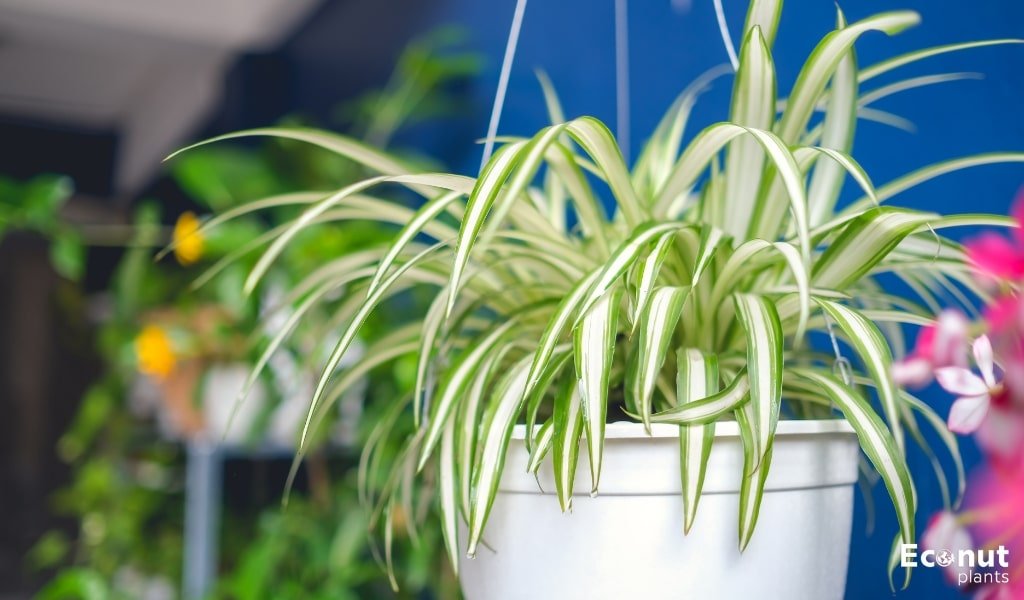Spider Plants Hanging Baskets are among the most popular plants. Provided they receive adequate care, these resilient houseplants grow rapidly and have a long lifespan. Gives her best tips for tough spider plants in hanging baskets in this post!
Choose a Smaller Basket
Spider plants are ideal hanging basket fillers since they can cascade. When the plant reaches maturity, its long, stiff leaves tower up and over, covering virtually the entire pot below.
There shouldn’t be more than two inches of space around the edges. If you don’t have enough space for spider plants, don’t worry about it. Relegated to their pots, they are content. For added visual interest, larger baskets can also be filled with complementary companion plants.
Pick a Light Container Material
When planting in hanging baskets, weight is a vital factor to take into account. Large pots get heavier when filled with earth, and even more so when damp. This has an impact on how easily you can maneuver as well as how you hang your basket.
One of the most used materials is plastic. If you need to repot or want to switch up the appearance of your indoor garden, plastic pots are also reasonably priced and simple to reuse.
You should have no issue using a lightweight, manageable object until the pot is filled. Even with sturdy hanging ropes, these pots are simply too heavy for hanging containers, despite their gorgeous appearance.
Use the Right Potting Soil
There are reasons other than the container’s material that can make a hanging basket heavy. Like most houseplants, spider plants require well-draining, airy soil to thrive. By using the proper soil mix while potting up, you can maintain the health of your plant by encouraging airflow and drainage around the roots.
When growing spider plants indoors, standard potting soil is far too heavy and dense. To promote drainage and airflow, use a well-prepared potting mix that has been fortified with additional ingredients, especially for indoor plants.
You can adjust this formula according to the location and amount of light your plant receives. Because additional light accelerates evaporation, you may need to modify your watering plan to use less perlite and more coir.
Hang at the Right Height
Hanging baskets can be difficult to manage indoors. Not only should they be placed out of the way to prevent needless mishaps, but they also shouldn’t be hung too high since this would hinder light access and significantly complicate watering.
Spider plants grow best near bright windows in areas that are not frequently visited by people, as they require brilliant indirect light. To get maximum absorption of indirect light, hang them at eye level or slightly below.
Your plant won’t get enough sunlight to flourish if it is hanging excessively high. Since evaporation may also slow down in certain areas, there is a potential that your plant will suffer from root rot. To avoid scowling and rolling your eyes as you consider watering them, make sure they are easily accessible.
Keep Away From Open Windows
Having enough airflow around your houseplants helps to avoid disease and enhances general health. But excess is undoubtedly harmful. The soil in containers dries up faster when drafts from open windows, whether they are warm or cold,
Even if it’s beneficial to put your plant in front of a light window, you should try to keep the window closed to prevent any powerful drafts from surrounding the plant.
Instead of powerful winds, there should be a calm breeze surrounding the hanging basket. You should either transfer your spider plant to a different area of your house or keep the windows closed if you notice that the air is regularly hurting the cascading leaves.
Take Down the Pot for Watering
It’s well known that spider plants can endure for a long time without water. They do, however, flourish most when given a rigorous watering schedule. We try to water them as soon as possible, but not so much that the extra runs off and lands on the floor through the drainage holes.
Take down the full pot to water, rather than damaging your floor and giving it improper watering. This enables you to completely wet the soil by distributing water evenly over a bucket or sink. Once the excess has drained out of the bottom of the pot, you can just hang it up again to continue growing normally.
Repot When Necessary
Even though your spider plant is hanging in a basket above, you still need to take care of it. For fast growers, this could happen once a year, but most frequently, it’s once every two or three years.
You have two options when repotting a plant: either split it up and use the same container, or put the whole thing in a bigger one. Having stated that partitioning is typically advised when problems arise with the weight and size of baskets.
Conclusion
Spider plants are a great option if you’re searching for indoor hanging basket plants. These plants can tolerate some neglect because they are resilient.
Plants with a tendency to spill their borders with leaves make some of the most exquisite hanging arrangements. Your spider plants will remain healthy and flourish for many years if you follow these few guidelines!

